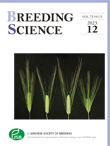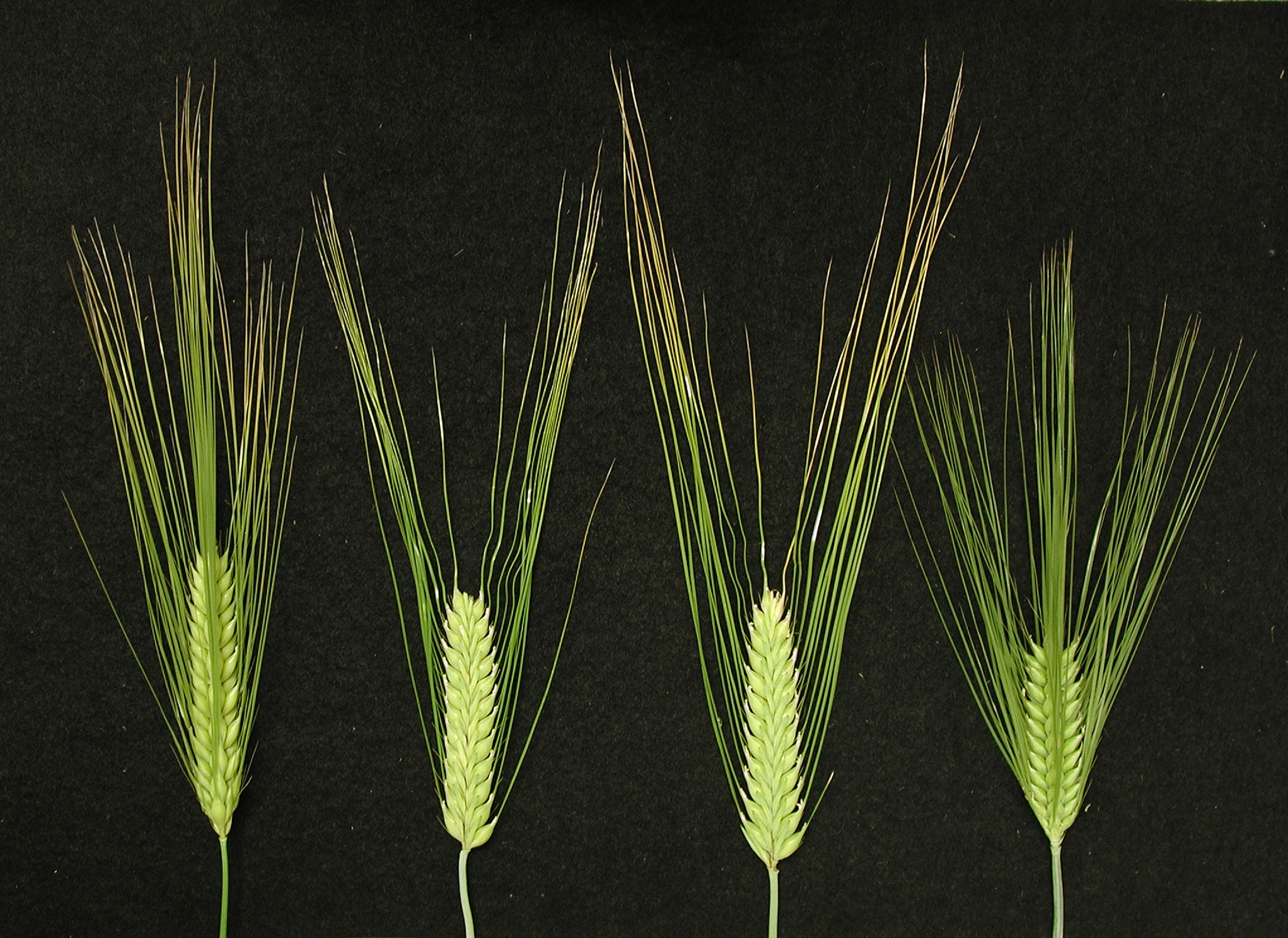
- Issue 5 Pages 421-
- Issue 4 Pages 355-
- Issue 3 Pages 237-
- Issue 2 Pages 95-
- Issue 1 Pages 1-
- |<
- <
- 1
- >
- >|
-
2023 Volume 73 Issue 5 Pages cover
Published: 2023
Released on J-STAGE: December 21, 2023
JOURNAL OPEN ACCESSOn the cover
Japanese modern malting barley breeding against barley yellow mosaic virus (BaYMV) disease: In Japan, BaYMV is the most serious disease that is transmitted through soil-borne RNA virus. This study clarified that the resistance gene rym3 of non-malting ‘Haganemugi’ (right) was independently introduced into two modern high-quality malting cultivars, ‘Sukai Golden’ (second from left) and ‘Sachiho Golden’ (third from left). ‘Sukai Golden’ additionally carries rym5 from Mokusekko 3 (left). Young spikes of each accession are shown (This issue, p. 435–444).
(S. Taketa: Institute of Plant Science and Resources, Okayama University)
 View full abstractDownload PDF (13744K)
View full abstractDownload PDF (13744K)
-
Chukwunonso Sylvanus Austin Ezeah, Juichi Shimazu, Takahiro Kawanabe, ...Article type: Research Paper
2023 Volume 73 Issue 5 Pages 421-434
Published: 2023
Released on J-STAGE: December 21, 2023
Advance online publication: November 01, 2023JOURNAL OPEN ACCESS FULL-TEXT HTML
Supplementary materialFusarium wilt is a significant disease in radish, but the genetic mechanisms controlling yellows resistance (YR) are not well understood. This study aimed to identify YR-QTLs and to fine-map one of them using F2:3 populations developed from resistant and susceptible radish parents. In this study, two high-density genetic maps each containing shared co-dominant markers and either female or male dominant markers that spanned 988.6 and 1127.5 cM with average marker densities of 1.40 and 1.53 cM, respectively, were generated using Genotyping by Random Amplicon Sequencing-Direct (GRAS-Di) technology. We identified two YR-QTLs on chromosome R2 and R7, and designated the latter as ForRs1 as the major QTL. Fine mapping narrowed down the ForRs1 locus to a 195 kb region. Among the 16 predicted genes in the delimited region, 4 genes including two receptor-like protein and -kinase genes (RLP/RLK) were identified as prime candidates for ForRs1 based on the nucleotide sequence comparisons between the parents and their predicted functions. This study is the first to use a GRAS-Di for genetic map construction of cruciferous crops and fine map the YR-QTL on the R7 chromosome of radish. These findings will provide groundbreaking insights into radish YR breeding and understanding the genetics of YR mechanism.
View full abstractDownload PDF (1209K) Full view HTML -
Shin Taketa, June-Sik Kim, Hidekazu Takahashi, Shunsuke Yajima, Yuichi ...Article type: Research Paper
2023 Volume 73 Issue 5 Pages 435-444
Published: 2023
Released on J-STAGE: December 21, 2023
Advance online publication: October 28, 2023JOURNAL OPEN ACCESS FULL-TEXT HTML
Supplementary materialTwo modern high-quality Japanese malting barley cultivars, ‘Sukai Golden’ and ‘Sachiho Golden’, were subjected to RNA-sequencing of transcripts extracted from 20-day-old immature seeds. Despite their close relation, 2,419 Sukai Golden-specific and 3,058 Sachiho Golden-specific SNPs were detected in comparison to the genome sequences of two reference cultivars: ‘Morex’ and ‘Haruna Nijo’. Two single nucleotide polymorphism (SNP) clusters respectively showing the incorporation of (1) the barley yellow mosaic virus (BaYMV) resistance gene rym5 from six-row non-malting Chinese landrace Mokusekko 3 on the long arm of 3H, and (2) the anthocyanin-less ant2 gene from a two-row Dutch cultivar on the long arm of 2H were detected specifically in ‘Sukai Golden’. Using 221 recombinant inbred lines of a cross between ‘Ishukushirazu’ and ‘Nishinochikara’, another BaYMV resistance rym3 gene derived from six-row non-malting Japanese cultivar ‘Haganemugi’ was mapped to a 0.4-cM interval on the proximal region of 5H. Haplotype analysis of progenitor accessions of the two modern malting cultivars revealed that rym3 of ‘Haganemugi’ was independently introduced into ‘Sukai Golden’ and ‘Sachiho Golden’. Residual chromosome 5H segments of ‘Haganemugi’ surrounding rym3 were larger in ‘Sukai Golden’. Available results suggest possibilities for malting quality improvement by minimizing residual segments surrounding rym3.
View full abstractDownload PDF (4620K) Full view HTML
-
Keita Kato, Yusuke Ban, Mikiko Yanaka, Shoya Kitabayashi, Hiroyuki Sek ...Article type: Note
2023 Volume 73 Issue 5 Pages 445-449
Published: 2023
Released on J-STAGE: December 21, 2023
Advance online publication: October 28, 2023JOURNAL OPEN ACCESS FULL-TEXT HTMLTan spot, a foliar disease of Triticum spp. such as bread wheat (T. aestivum L.) and durum wheat (T. turgidum ssp. durum (Desf.) Husn.) caused by the filamentous fungus Pyrenophora tritici-repentis (Died.) Drechsler leads to serious losses of crop yield and quality in some areas in Japan. P. tritici-repentis is classified into eight races according to the combinations of three necrotrophic effectors, PtrToxA, PtrToxB, and PtrToxC encoded by ToxA, ToxB, and ToxC1, respectively. Race classification has been based on reaction of a differential variety to necrotrophic effectors, which is tested by inoculation. Recent identification of the Tox genes and development of specific DNA markers have enabled us to classify races of P. tritici-repentis collected in Japan by Tox gene genotyping. We found that 17 strains collected from Triticum spp. in Japan were mainly race 1 or 2, because they carried ToxA as a toxin gene by current race classification; wheat genotype tsn1 is resistant to ToxA. Establishment of wheat cultivars carrying tsn1 would be most effective for decreasing agronomic losses caused by the disease in Japan.
View full abstractDownload PDF (1386K) Full view HTML -
Md. Mostofa Kamal, Cuong Dinh Nguyen, Sachiyo Sanada-Morimura, Shao-Hu ...Article type: Note
2023 Volume 73 Issue 5 Pages 450-456
Published: 2023
Released on J-STAGE: December 21, 2023
Advance online publication: October 31, 2023JOURNAL OPEN ACCESS FULL-TEXT HTML
Supplementary materialThe development of resistant rice (Oryza sativa L.) varieties is a key strategy for the eco-friendly control of brown planthopper (BPH: Nilaparvata lugens Stål). However, BPH outbreaks occur frequently owing to the evolution of virulent strains in the field and the rapid breakdown of monogenic resistance to BPH. Therefore, to enhance BPH resistance and gauge the effectiveness of gene pyramiding against strongly virulent BPH, we developed pyramided lines (PYLs) in the genetic background of ‘IR64’ carrying BPH resistance genes. We developed six IR64-PYLs (BPH3 + BPH17, BPH32 + BPH17, BPH32 + BPH20, BPH3 + BPH17-ptb, BPH20 + BPH3, and BPH17-ptb + BPH32) through marker-assisted selection. To assess the resistance of the IR64-PYLs, we conducted antibiosis test, honeydew test, and modified seedbox screening test (MSST) using strongly virulent BPH populations. The level of BPH resistance increased in all six IR64-PYLs compared to both ‘IR64’ and the corresponding NILs in MSST. Among them, IR64-BPH3 + BPH17 and IR64-BPH32 + BPH17 exhibited the highest resistance to BPH. However, the resistance level of most IR64-PYLs was not significantly higher than that of the corresponding NILs in antibiosis test. Thus, these PYLs could serve as a valuable resource for breeding programs aimed at improving resistance to virulent strains of BPH and enhancing their durability.
View full abstractDownload PDF (437K) Full view HTML
-
2023 Volume 73 Issue 5 Pages i-iii
Published: 2023
Released on J-STAGE: December 21, 2023
JOURNAL OPEN ACCESSDownload PDF (571K)
- |<
- <
- 1
- >
- >|